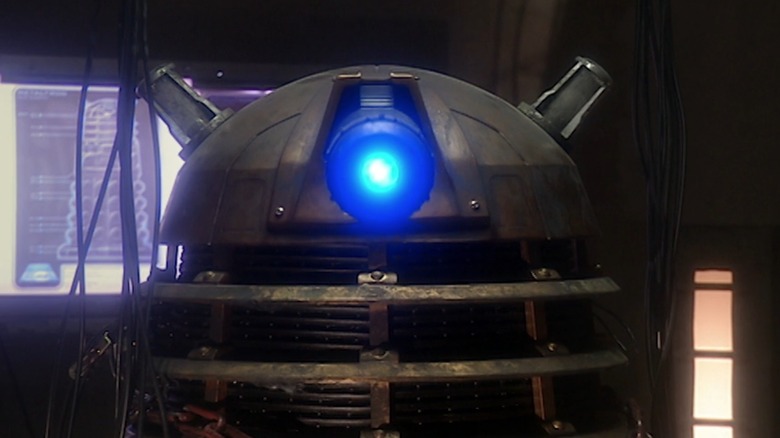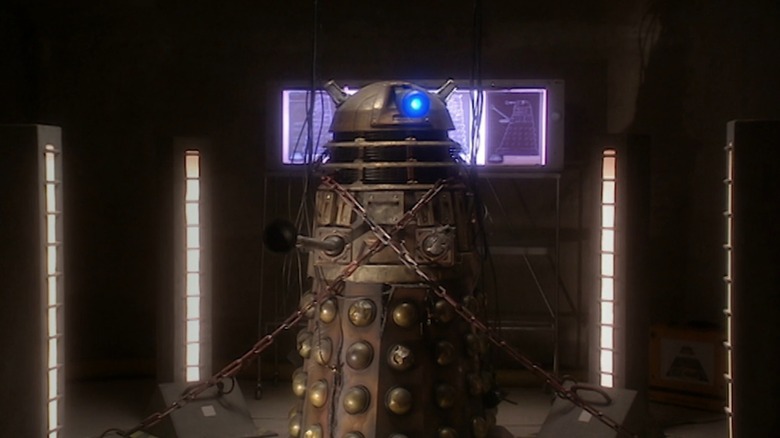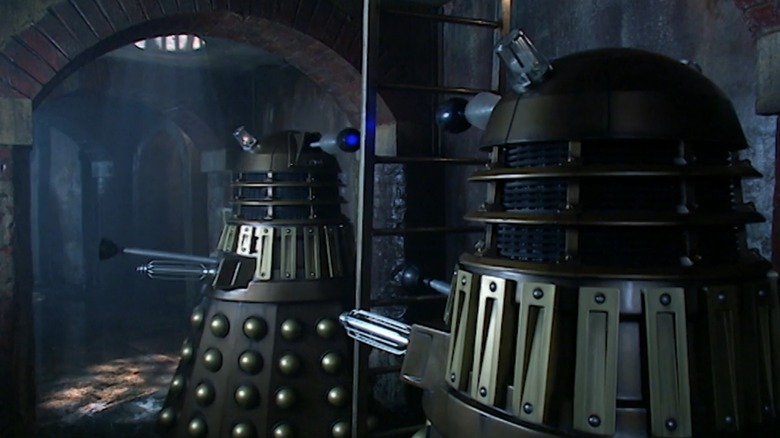This Is How The Daleks Were Really Controlled In Doctor Who
Daleks are one of the most iconic villains of "Doctor Who," having been on the show since its very first season in 1963. They look like human-sized tanks: Armed with a plunger and a whisk, they glide around saying "Exterminate!" with all the gusto of an overexcited first-generation Siri. Inside, a mutated lump of flesh controls the shell, with nothing but destruction on its mind. They're the Doctor's greatest enemy, both terrifying and perfect for merchandising.
Screenwriter Terry Nation first created the Daleks when he wrote the second "Doctor Who" story: The seven-part series titled simply "The Daleks." Production designer Raymond Cusick then brought them to life — on a very limited budget — with his prop design and they became massively popular among the show's fans. All these years later, they're still a mainstay of the series, but the Dalek design has changed a little from then to now. In particular, they're easier to control now because of a few key tweaks.
There's a person sitting inside!
Instead of a little flesh monster, on the set there's a regular person inside the Dalek shell: The Dalek operator sits on a seat inside the hollow prop and moves it with their feet. Wheels on the base help the operator achieve the gliding motion while they peer out through holes in the Dalek's neck. On the original run of "Doctor Who," the operator was in charge of both arm attachments, the smoke canister, the head rotation, the eyestalk, and the lights that blink when it speaks — it was a challenge to do it all.
When the Daleks were brought back for the 2005 run of the show, however, the Dalek movement became a two-person job: The operator inside moves the body, the sucker (aka the plunger), and the exterminator (aka the whisk), while a second person uses a remote control to move the head and eyestalk (via Doctor Who Confidential). Early on, the remote control user did the light commands, but later that responsibility was given to the Dalek voice actor. Without so much to do, the new era of Dalek operators can focus on moving smoothly through the scene.
"You need very, very good grip trainers and strong legs; those are the principal qualities of a Dalek operator," Dalek operator Barnaby Edwards told Sci-fi Now. "You also need a lack of claustrophobia and the ability to sit for long periods of time in a tin can." Inside, there's very limited visibility, which is only worsened by the black cloth hood the operator has to wear to cover the whites of their eyes. In order to time their performance with the Dalek's voice, the lines are radioed into the shell. It's still a tough job, but no longer does the operator need six hands to do it all.
But you're not supposed to know there's a person inside
The whole Dalek design was based around someone having to operate it from the inside, but at the same time, it was meant to appear like it wasn't controlled by a person at all. When first writing the Daleks, Terry Nation knew he wanted the alien to look completely different from a human. "I'd grown up watching movies and was always vaguely disappointed because I knew the monsters were people," he said. "I didn't want it to look like somebody dressed up in a funny costume, so I had to eliminate the legs." As for their gliding motion, he found inspiration from watching dancers in long skirts.
Given those specifics, Raymond Cusick figured they would need someone inside the thing, controlling it. "If you had anything mechanical, 10 to one on the take it would go wrong, so you've got a human being in there who would be absolutely totally reliable," he said. So first, he started with giving that operator something to sit on, then he drew the shape around a seated person, and designed the rest from there (via BBC).
"People do kind of forget that we're in there," Dalek operator Nicholas Pegg said. "It's a testament to what an amazing piece of design it is that it comes to life and people think it's just a Dalek." However, the one thing the Dalek props are missing is the voice: The Dalek voice actor — Nicholas Briggs — is on set, speaking into a voice modulator and timing the lights with his lines. "I feel like I'm a one-man band," he said. "I always do different voices for all the different Daleks ... They all have their own little mad personalities, in my head anyway."


